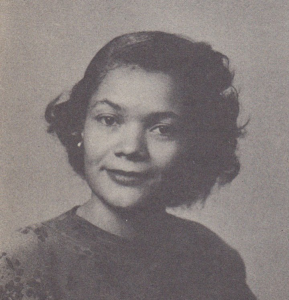Carolyn Parker was the first African American woman to receive a graduate degree in physics. Carolyn Parker was born on November 18, 1917 in Gainesville, Florida. She was born into a family of other incredible scientists. Her father, Julius A. Parker was a medical doctor, who was the second African American to graduate with a PhD in business from Harvard University. Parker’s aunt, Joan Murrell Owens, was the first African American woman to earn a PhD in geology, which she used to study marine biology. All of Carolyn Parker’s siblings were also scientists studying subjects ranging from mathematics to social science.
Carolyn Parker attended Fisk University, a traditionally black university, in Nashville, TN. Here, she earned her Bachelor of Arts degree in Mathematics, graduating magna cum laude. Parker then attended Michigan University where she earned a master’s degree in mathematics. This degree helped her gain a teaching position at Bluefield State College – another historically black college in West Virginia that was pivotal to the eruption of black education and culture. At Bluefield State College, Parker taught physics and mathematics
In 1943 Parker was recruited to work on the Dayton Project – a special arm of the Manhattan Project. The Manhattan Project was a government research project that came about in 1942 during World War II. This project specifically revolved around the manufacturing, researching, and intelligence gathering of nuclear weapons. The Dayton Project, the branch Parker was involved in, was centered mostly on studying polonium. Polonium is a chemical element with atomic number 84. It was originally discovered by Marie Curie who named it after her homeland of Poland. Polonium, and its many isotopes, have incredibly short half-lives which makes it very rare. In fact, the largest quantity of 210Po (the isotope of polonium with the longest half-life) ever extracted was only 9 milligrams out of 37 tons of radium waste. Just to clarify, that 9 milligrams of polonium weighs less than your standard rice grain! Polonium is also radioactive. This means that polonium is very toxic to most organisms. The toxicity of this fascinating element was, unfortunately, not well examined in the time Carolyn Parker was working with it.
 While researching the intricacies of polonium on the Dayton Project, Parker continued pursuing her studies. She took classes at Ohio State University to further her education in physics. Most impressively, however, Carolyn Parker went on to receive a master’s degree in physics from MIT. This made her the first African American woman to earn a graduate degree in physics. Parker’s completion of this graduate degree was a significant step in accepting African American women and other women of color into physics and mathematics based programs. Parker also went on to begin working toward her doctorate in physics at MIT but was unable to graduate due to failing health.
While researching the intricacies of polonium on the Dayton Project, Parker continued pursuing her studies. She took classes at Ohio State University to further her education in physics. Most impressively, however, Carolyn Parker went on to receive a master’s degree in physics from MIT. This made her the first African American woman to earn a graduate degree in physics. Parker’s completion of this graduate degree was a significant step in accepting African American women and other women of color into physics and mathematics based programs. Parker also went on to begin working toward her doctorate in physics at MIT but was unable to graduate due to failing health.
In 1966, Carolyn Parker died of leukemia at the young age of 47 before finishing her PhD. It was later discovered that leukemia is a risk of polonium exposure. In the time that Parker was working with polonium and other radioactive materials, little was known of the risks of overexposure. Nowadays, institutions routinely monitor the use and traces of radioactive materials to make them safe for scientists to work with.
 It is because of the continuous efforts of Carolyn Parker to pursue her education that she was able to become the first African American woman to earn a postgraduate degree in physics – but most certainly not the last! Carolyn Parker was one of many black scientists that provided major contributions to the Manhattan Project. Others that contributed to the Manhattan Project and its many divisions, like J Ernest Wilkens Jr. and Harold Delaney, went on to further advance their scientific fields and establish educational tools for young people of color in science. Their efforts created many opportunities for people of color wishing to obtain degrees – particularly in mathematics and physics. It is because of their willingness to learn and design access for others that so many scientists of all different backgrounds are able to pursue their goals and contribute to all different scientific studies.
It is because of the continuous efforts of Carolyn Parker to pursue her education that she was able to become the first African American woman to earn a postgraduate degree in physics – but most certainly not the last! Carolyn Parker was one of many black scientists that provided major contributions to the Manhattan Project. Others that contributed to the Manhattan Project and its many divisions, like J Ernest Wilkens Jr. and Harold Delaney, went on to further advance their scientific fields and establish educational tools for young people of color in science. Their efforts created many opportunities for people of color wishing to obtain degrees – particularly in mathematics and physics. It is because of their willingness to learn and design access for others that so many scientists of all different backgrounds are able to pursue their goals and contribute to all different scientific studies.
Edited by Rachel Battaglia and Yogitha Chareddy

